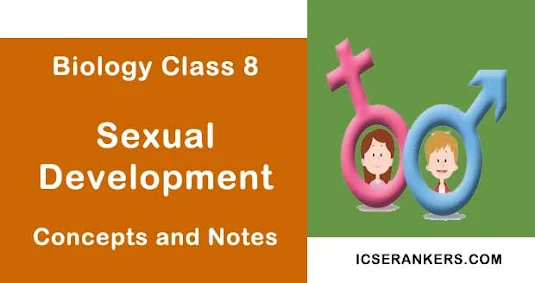Sexual Development- Biology Guide for Class 8
Information about Sexual Development
Title | Sexual Development |
Class | Class 8 |
Subject | Class 8 Biology |
Topics Covered |
|
Sexual Development
Development of Sex Organs
During puberty, physical and sexual developments take place more or less at the same time.
- The sex organs of boys and girls start developing.
- Testes in boys mature. They start producing semen.
- In girls, the reproductive organs are strengthened. The ovaries enlarge and the production of ova begins. The ovaries release mature ova.
- The girls start their monthly menstruation cycle.
Development of Secondary Sexual Characters
The development of secondary sexual characters also takes place.
- It starts in boys with the appearance of pubic and facial hair.
- In girls, the breasts start developing and the appearance of pubic hair takes place. Body hair also become prominent.
Change in Hormonal Balance
Most of the changes, that occur in adolescents, are controlled by hormones.
- Hormones are the chemical substances produced and secreted by the endocrine glands.
- Hormonal balance in adolescents shifts strongly towards an adult state. This is triggered by the pituitary gland.
- Pituitary secretes hormones; these influence the production of testosterone (from testes) in boys, and estrogen and progesterone (from ovaries) in girls.
- These hormones are released into the blood stream and start the rapid maturation of the gonads (sex organs).
The Reproductive Phase in Human Beings
Humans become capable of reproduction when their testes and ovaries begin to produce gametes—the sperms and the ova. The males produce gametes over a longer duration in their life as compared to females.
- In females, the ovaries become active when the girl reaches puberty; this is normally, between 11-13 years of age.
- One ovum, in one of the ovaries, becomes mature once in about 28 days.
- The mature ovum enters the oviduct where it may get fertilised.
- If fertilised, it develops and reaches the uterus—a pear-shaped structure present between the ovaries.
- Uterus is muscular and elastic and can grow, stretch and expand many times its size when the foetus grows and develops inside it.
- Before the embryo enters the uterus, the uterus prepares itself to receive it by forming a thick lining of blood vessels.
- If fertilisation does not occur, the egg disintegrates and the lining of blood vessels is shed off. This process of blood flow is termed as menstruation. It lasts 3-6 days.
- The first menstrual flow, that begins in a girl at puberty, is termed menarche.
- The menstrual cycle stops when the woman reaches 45-50 years of age. This is termed as menopause.
- In general, menstruation occurs regularly at intervals of 28-30 days. However, this period can be variable.
- It may take about six months to one year for a girl's menstrual periods to become regular; normally this should not cause any worry.
- If the ovum is fertilised by the sperm, a zygote is formed that begins to divide and gets embedded in the uterus for further development.
Determination of Sex of the Child
Human beings have 46 chromosomes in the nuclei of their cells. Of these, 44 are known as autosomes and the last pair is termed as the sex chromosomes. This last pair is different in males and females. In males, it is XY and in females it is XX.
The gametes (ovum and sperm) have half the number of chromosomes as that of cells occurring elsewhere in the body. This means that an egg will always have (22 + X) chromosomes while a sperm will have either (22 + X) or (22 + Y) chromosomes.
- During fertilisation, if an egg fuses with a (22 + Y) sperm, the resultant zygote will develop into a male child.
- If an egg fuses with a (22 + X) sperm, the resultant zygote will develop into a female child.
After understanding this, can you now analyse, which of the two, the father, or the mother, is responsible for determining the sex of the child.



